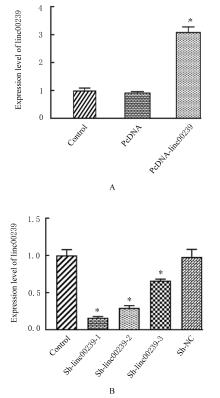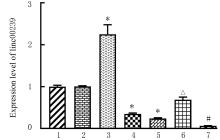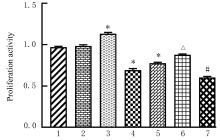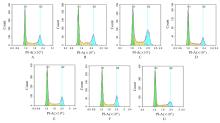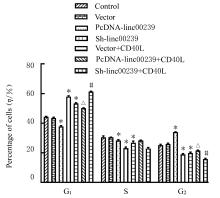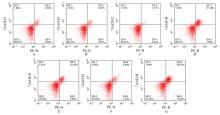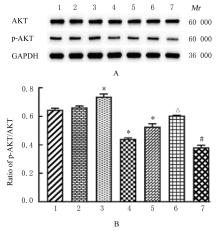| [1] |
Huijuan SONG,Zhenhua XU,Dongning HE.
Effect of apolipoprotein C1 expression on proliferation and apoptosis of human liver cancer HepG2 cells and its mechanism
[J]. Journal of Jilin University(Medicine Edition), 2024, 50(1): 128-135.
|
| [2] |
Yaxin LIU,Jian LIU,Zhen LI,Zhanhong CAO,Haonan BAI,Yu AN,Xingyu FANG,Qing YANG,Hui LI,Na LI.
Inhibitory effect of royal jelly acid on proliferation of human colon cancer SW620 cells and its network pharmacological analysis
[J]. Journal of Jilin University(Medicine Edition), 2024, 50(1): 150-160.
|
| [3] |
Yan WANG,Xiaohui LI,Yao JI,Lili CUI,Yujie CAI.
Differential effects of APOE polymorphism in neurotoxicity-responsive astrocytes induced by inflammatory factor
[J]. Journal of Jilin University(Medicine Edition), 2024, 50(1): 33-41.
|
| [4] |
Mengxue WU,Shiling CHEN,Yan LIU,Xuguang MI,Xiuying LIN,Jianhua FU,Yanqiu FANG.
Effect of culture supernatant of human umbilical cord mesenchymal stem cells on survival,apoptosis and endometrium receptivity of human endometrial stromal cells after treated with mifepristone
[J]. Journal of Jilin University(Medicine Edition), 2024, 50(1): 79-87.
|
| [5] |
Xiaoni WANG,Tao GUO,Qiyun LUO,Lifeng GUAN.
Effect of usnic acid on biological behaviors of hypertrophic scar fibroblasts and JNK/MAPK signaling pathway
[J]. Journal of Jilin University(Medicine Edition), 2023, 49(6): 1445-1451.
|
| [6] |
Ruipeng ZHANG,Jie LI.
Resistance and regeneration effects of lncRNA GPRC5D-AS1 on muscle atrophy of myocytes in mice induced by dexamethasone and its mechanism
[J]. Journal of Jilin University(Medicine Edition), 2023, 49(6): 1457-1465.
|
| [7] |
Aihua REN,Xinda JU,Aofei LIU,Yongchao LIU,Yanfeng LIU.
Effect of ganoderic acid A on proliferation and apoptosis of human non-small cell lung cancer PC-9 cells and its mechanism
[J]. Journal of Jilin University(Medicine Edition), 2023, 49(6): 1466-1472.
|
| [8] |
Lu FU, Yanjue YE, Jiangying LI, Ziyi TANG, Li YIN.
Expressions of Sirtuins protein in testis tissue and GC-2 cells in male reproductive system damage model mice induced by bisphenol A and their significances
[J]. Journal of Jilin University(Medicine Edition), 2023, 49(5): 1107-1116.
|
| [9] |
Xing LIU,Jiali LIU,Liangui NIE,Maojun LIU,Junxiong ZHAO,Liuyang WANG,Jun YANG.
Improvement effect of SO2 on myocardial fibrosis after acute myocardial ischemic injury in rats and its mechanism
[J]. Journal of Jilin University(Medicine Edition), 2023, 49(5): 1125-1133.
|
| [10] |
Na NI,Hongliang DONG,Haiyang GAO,Weiwei CHEN,Xinyu MENG,Bingjie CUI,Jing DU.
Construction of human lncRNA-GACAT2 over-expression vector and its effect on proliferation and stemness of lung cancer cells
[J]. Journal of Jilin University(Medicine Edition), 2023, 49(5): 1147-1153.
|
| [11] |
Yong GUO,Shengyan WANG,Jingjing YI,Sen CUI.
Effect of salidroside on apoptosis of CD71+ nucleated red blood cells in bone marrow in high altitude polycythemia model rats
[J]. Journal of Jilin University(Medicine Edition), 2023, 49(5): 1174-1181.
|
| [12] |
Yuanying SONG,Jing KAN,Kun PENG,Yue LI.
Effect of honeysuckle extract on proliferation and apoptosis of airway smooth muscle cells in asthmatic model mice
[J]. Journal of Jilin University(Medicine Edition), 2023, 49(4): 1001-1007.
|
| [13] |
Meng LIU,Xiaodong HUANG,Zheng HAN,Qingxi ZHU,Jie TAN,Xia TIAN.
Effect of cadherin-17 on proliferation and apoptosis of colorectal cancer cells and its PI3K/AKT/mTOR signaling pathway regulatory mechanism
[J]. Journal of Jilin University(Medicine Edition), 2023, 49(4): 1008-1017.
|
| [14] |
Chang GAO,Yan LIU,Haoxiang YANG,Cuicui ZHANG.
Effect of long non-coding RNA MALAT1 on angiogenesis of human brain microvascular endothelial cells induced by oxygen-glucose deprivation/reoxygenation hypoxic
[J]. Journal of Jilin University(Medicine Edition), 2023, 49(4): 832-839.
|
| [15] |
Xuying WANG,Mingzhen JING,Jin YU,Rong FU,Ru YANG.
Effects of miR-181a-5p and BACH2 expressions on apoptosis and invasion of leukemic CCRF-CEM cells
[J]. Journal of Jilin University(Medicine Edition), 2023, 49(4): 840-849.
|

